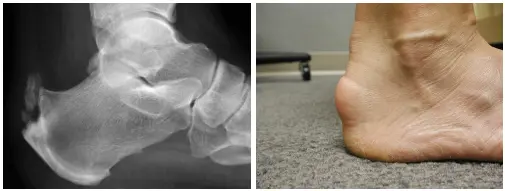Achilles tendinopathy - clinical fact sheet and MCQ
Overview
Achilles tendinopathy is a common cause of posterior heel pain and functional impairment, especially in physically active individuals and older adults. There are two main clinical entities: noninsertional (mid-portion) and insertional tendinopathy.
Noninsertional tendinopathy typically affects younger, active individuals and occurs 2–6 cm proximal to the calcaneal insertion. In contrast, insertional tendinopathy involves the tendon’s enthesis at the calcaneus and is more prevalent in middle-aged or less active individuals. The condition is thought to result from repetitive mechanical overload, leading to tendon degeneration rather than inflammation.
Despite its chronicity and potential impact on mobility, Achilles tendinopathy usually responds well to conservative management, though a subset of patients may require surgical intervention.
Risk factors for Achilles tendinopathy
- Overuse or recent increase in physical activity
- Gastrocnemius-soleus tightness
- Mechanical irritation from Haglund deformity or inappropriate footwear, such as shoes with inadequate heel or arch support, shoes that rub the back of the heel and shoes with insufficient cushioning
- Systemic conditions associated with Achilles tendinopathy: diabetes mellitus, hypercholesterolaemia, inflammatory arthropathies (eg ankylosing spondylitis, psoriatic arthritis)
- Fluoroquinolone or corticosteroid use
Diagnosis of Achilles tendinopathy
A clinical history and physical examination are essential for diagnosis. Patients often report pain and stiffness localised to the posterior heel, particularly after periods of rest or with activity. Pain may initially be intermittent but can progress to persistent discomfort.
In insertional tendinopathy, tenderness is localised at the calcaneal insertion, often accompanied by swelling or a palpable prominence due to calcific deposits or a Haglund deformity (an enlargement of the posterosuperior tuberosity of the calcaneus). A Silfverskiöld test can diagnose gastrocnemius tightness which can contribute to Achilles tendinopathy.
Noninsertional cases show tenderness 2–6 cm above the insertion, where the tendon is more hypovascular.
-
Differential diagnoses
-
- Retrocalcaneal bursitis (pain anterior to the tendon; can also be present with Achilles tendon disorders)
- Plantar fasciitis (plantar heel pain)
- Calcaneal stress fracture (activity-related pain, positive squeeze test)
- Sural nerve entrapment (posterolateral ankle pain and sensory disturbances radiating down the lateral foot)
- Posterior ankle impingement (deep posterior ankle pain worsened by forced plantarflexion)
-
Red flags
-
- Swollen, warm or tender joints (intra-articular pathology)
- Systemic symptoms (suggestive of inflammatory arthropathy or infection)
- Sudden onset of pain or weakness (possible tendon rupture)
- Bony lump or skin tenting (possible calcaneal tuberosity avulsion fracture)
Investigations
-
Plain radiographs (weight-bearing lateral views) to assess for enthesophytes, Haglund deformity, or calcific changes (image 1)

Image 1: Haglund deformity (source credit: https://www.orthobullets.com/foot-and-ankle/7022/achilles-tendonitis)
- Ultrasound provides a dynamic assessment of tendon structure and vascularity
- MRI is useful for pre-surgical planning and in refractory cases; demonstrates tendon degeneration, bursitis, and bone marrow oedema
Management of Achilles tendinopathy
- Non-surgical management is the first-line approach and should be trialled for a minimum of 3 to 6 months:
-
- exercise therapy: eccentric loading (muscle contracting while it's lengthening) is the cornerstone. For insertional tendinopathy, modified protocols that avoid dorsiflexion beyond neutral are more effective and better tolerated. Sample exercise programs can be viewed here.
- extracorporeal shock wave therapy (ESWT): consider in patients who fail exercise-based rehabilitation; may reduce pain more effectively than eccentric exercise alone
- footwear modifications: use of heel lifts, backless shoes, or softer heel counters to reduce compression at the tendon insertion
- physiotherapy: including deep tissue mobilisation, stretching, and progressive resistance training
- pain management: use of paracetamol or NSAIDs as needed, though evidence of long-term benefit is limited
Other adjuncts (eg soft tissue therapy, injections, nutritional supplements) have insufficient evidence to recommend routine use.
-
Referral to an orthopaedic surgeon with interest in foot/ankle is indicated if:
-
- no improvement after 6 months of structured, guideline-based conservative management
- significant structural abnormalities on imaging (eg >50% tendon degeneration)
- functional impairment or inability to return to desired activity levels
- consideration of surgical options is required
-
Surgical options include:
-
- debridement of diseased tendon and resection of calcific deposits or bony prominence (Haglund deformity)
- tendon repair and reattachment using suture anchors
- flexor hallucis longus tendon transfer (in cases with significant tendon loss)
- calcaneal osteotomy (in refractory cases with underlying bony malalignment)
Outcomes following surgery are generally good, though return to full activity can take up to 12 months. Persistent or recurrent calcifications may occur but often do not correlate with symptom severity.
References
- Touzell A. The Achilles tendon: Management of acute and chronic conditions. Aust J Gen Pract. 2020;49(11):715–9.
- Chen J, Janney CF, Khalid MA, Panchbhavi VK. Management of insertional Achilles tendinopathy. J Am Acad Orthop Surg. 2022;30(10):e751–9.
- Dilger CP, Chimenti RL. Nonsurgical treatment options for insertional Achilles tendinopathy. Foot Ankle Clin. 2019;24(4):505–13.
- Shakked RJ, Raikin SM. Insertional tendinopathy of the Achilles: Debridement, primary repair, and when to augment. Foot Ankle Clin. 2017;22(4):761–80.
- Hennessy MS, Molloy AP, Sturdee SW. Noninsertional Achilles tendinopathy. Foot Ankle Clin. 2007;12(4):617–41.
- Physiopedia. Achilles tendinopathy. 2025. Available at: https://www.physio-pedia.com/Achilles_Tendinopathy#:~:text=Recently%2C%20it%20was%20suggested%20that,patients%20with%20a%20diagnosis%20Achilles (last accessed Sept 2025).
Claim your CPD
After reading the clinical summary above and reviewing the references, complete the quiz to gain 30 minutes of EA CPD and 30 minutes of RP CPD.
You can either self-report CPD to your CPD home, or Medcast will track your learning via your personal CPD Tracker and you can download and report these points once a year. See our CPD Tracker FAQ.
Quiz
Please log in or sign up for a free Medcast account to access the case study questions and achieve the CPD credits.
The Medcast medical education team is a group of highly experienced, practicing GPs, health professionals and medical writers.
Become a member and get unlimited access to 100s of hours of premium education.
Learn moreCo-billing and split billing are often a source of confusion for many GPs. This FastTrack clearly defines these two methods of billing, including examples, explanations of when it is and isn’t appropriate to co- or split bill, and common compliance pitfalls. 30 mins each RP and EA available with the quiz.
The Coordinated Veterans’ Care (CVC) Program is a DVA initiative that allows GPs to provide structured, proactive care in the community for eligible veterans and war widows. This FastTrack provides a guide to billing the CVC program, and outlines a strategy for its practice-wide integration.
Over 3% of GP consultations in Australia involve skin lesions, yet many practices are billing these procedures incorrectly, putting themselves at risk of noncompliance or missing out on legitimate remuneration. This Business skills FastTrack explains the MBS item numbers pertaining to skin lesions for GPs, including eligibility criteria and practical tips.

